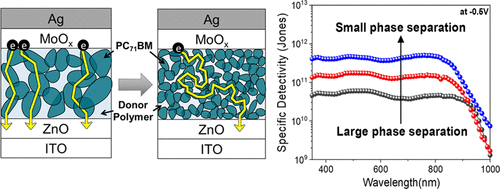当前位置:
X-MOL 学术
›
ACS Photonics
›
论文详情
Our official English website, www.x-mol.net, welcomes your
feedback! (Note: you will need to create a separate account there.)
Unraveling the Origin of Dark Current in Organic Bulk Heterojunction Photodiodes for Achieving High Near-Infrared Detectivity
ACS Photonics ( IF 6.5 ) Pub Date : 2022-05-16 , DOI: 10.1021/acsphotonics.2c00193 Enoch Go 1, 2 , Hyunjung Jin 1, 2 , Seongwon Yoon 1 , Sungmin Park 1 , So Hyun Park 1, 2 , Hyeonggeun Yu 1 , Hae Jung Son 1, 2
ACS Photonics ( IF 6.5 ) Pub Date : 2022-05-16 , DOI: 10.1021/acsphotonics.2c00193 Enoch Go 1, 2 , Hyunjung Jin 1, 2 , Seongwon Yoon 1 , Sungmin Park 1 , So Hyun Park 1, 2 , Hyeonggeun Yu 1 , Hae Jung Son 1, 2
Affiliation

|
Organic infrared materials are attractive due to their high absorption coefficients and facile tuning of the absorption spectrum beyond that of silicon. Although bulk heterojunctions (BHJs) are widely used in organic photodetectors (OPDs), achieving a high signal-to-noise ratio in the near-infrared spectrum is often challenging due to the inherently large dark currents in low-bandgap polymers and their blending morphology effect. Herein, we investigate the origin of dark currents in near-infrared OPDs and reveal a strategy to improve the detectivity in terms of two aspects: (1) donor–acceptor blending morphology and (2) effects of carrier injection from outer electrodes. To do so, a series of random terpolymers were synthesized in a similar band structure and their blending morphology with the PC71BM acceptor was gradually controlled. As the phase separation was smaller, the dark current gradually reduced while the responsivity increased, leading to a higher detectivity. Complex charge-transporting paths formed under the fine percolating network account for the dark current reduction, while the increased heterojunction area facilitates the dissociation of the photogenerated excitons. From our thermal admittance spectroscopy, deeper sub-bandgap states were found under the smaller phase separation, further contributing to the dark current reduction. Second, the carrier injection effect was revealed by inserting a charge-blocking layer at the active layer/electrode interface. While manipulating both parameters could yield a high near-infrared detectivity up to 1012 Jones at −0.5 V, the blending morphology effect turns out to be more dominant over the carrier injection effect in suppressing the dark current and achieving higher detectivity in BHJ OPDs.
中文翻译:

揭示有机体异质结光电二极管中暗电流的起源,以实现高近红外探测
有机红外材料具有吸引力,因为它们具有高吸收系数和比硅更容易调节吸收光谱。尽管体异质结 (BHJ) 广泛用于有机光电探测器 (OPD),但由于低带隙聚合物固有的大暗电流及其混合形态,在近红外光谱中实现高信噪比通常具有挑战性影响。在这里,我们研究了近红外 OPD 中暗电流的来源,并从两个方面揭示了提高检测率的策略:(1)供体-受体混合形态和(2)外电极载流子注入的影响。为此,我们合成了一系列具有相似能带结构的无规三元共聚物及其与 PC 71的共混形态BM受体逐渐受到控制。随着相分离变小,暗电流逐渐减小而响应度增加,从而导致更高的检测率。在精细渗透网络下形成的复杂电荷传输路径导致暗电流减少,而增加的异质结面积有利于光生激子的解离。从我们的热导纳光谱中,在较小的相分离下发现了更深的亚带隙状态,进一步促进了暗电流的减少。其次,通过在有源层/电极界面处插入电荷阻挡层来揭示载流子注入效应。同时操纵这两个参数可以产生高达 10 12的高近红外探测率Jones 在 -0.5 V 时,混合形态效应在抑制暗电流和在 BHJ OPD 中实现更高检测率方面比载流子注入效应更占优势。
更新日期:2022-05-16
中文翻译:

揭示有机体异质结光电二极管中暗电流的起源,以实现高近红外探测
有机红外材料具有吸引力,因为它们具有高吸收系数和比硅更容易调节吸收光谱。尽管体异质结 (BHJ) 广泛用于有机光电探测器 (OPD),但由于低带隙聚合物固有的大暗电流及其混合形态,在近红外光谱中实现高信噪比通常具有挑战性影响。在这里,我们研究了近红外 OPD 中暗电流的来源,并从两个方面揭示了提高检测率的策略:(1)供体-受体混合形态和(2)外电极载流子注入的影响。为此,我们合成了一系列具有相似能带结构的无规三元共聚物及其与 PC 71的共混形态BM受体逐渐受到控制。随着相分离变小,暗电流逐渐减小而响应度增加,从而导致更高的检测率。在精细渗透网络下形成的复杂电荷传输路径导致暗电流减少,而增加的异质结面积有利于光生激子的解离。从我们的热导纳光谱中,在较小的相分离下发现了更深的亚带隙状态,进一步促进了暗电流的减少。其次,通过在有源层/电极界面处插入电荷阻挡层来揭示载流子注入效应。同时操纵这两个参数可以产生高达 10 12的高近红外探测率Jones 在 -0.5 V 时,混合形态效应在抑制暗电流和在 BHJ OPD 中实现更高检测率方面比载流子注入效应更占优势。











































 京公网安备 11010802027423号
京公网安备 11010802027423号